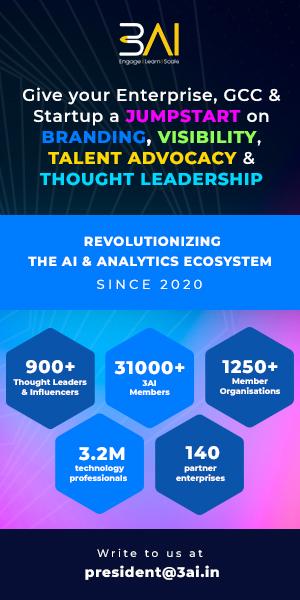ML & Data Science Solutions: Build, Buy or Outsource?
3AI April 15, 2021

Data and analytics leaders increasingly believe that data science is a critical component of their analytics and business intelligence (BI) modernization plans, and are clamoring to incorporate new. Technologies such as predictive analytics, machine learning and deep neural nets sit at the Peak of Inflated Expectations on related Gartner Hype Cycle. While some degree of backlash in the face of overinflated value propositions and underwhelming early results is inevitable, overall an increasing number of organizations are achieving tangible benefits from data science initiatives, and investment in solutions continues to grow.
As with other IT capabilities, there are three basic approaches to obtaining machine-learning and data science solutions: building, buying or outsourcing. The following eight questions should guide internal discussions devoted to deciding which solution path is best-suited to your organization.
1. Is There a Packaged Application Available That Exactly Solves the Analytical Problem at Hand?
This is the first question you should ask when tackling a new analytics problem. Using a packaged application is typically the fastest route to applying machine learning and data science. According to Gartner research, analytic applications and performance management represent 15% of total spend in the entire BI and analytics market. Leverage your current vendor relationships to evaluate their offerings and explore bundling solutions. Use the Hype Cycles to learn naming conventions, clarify definitions and descriptions, and look up analysts covering various topics.
2. Is There a Packaged Application Available That Meets Many of — Though Not All — Your Requirements?
Even if there is no packaged application available that is perfectly suited to a particular analytical scenario, packaged applications can often provide a “good enough” solution that delivers rapid ROI. Time to solution is a strength for packaged applications, which can minimize opportunity costs. Such applications can also serve as a stopgap until other solutions can be developed and implemented. Have an honest internal discussion on what “good enough” means for your organization.
3. Is There a Packaged Application Available That Meets All Criteria, but Is Difficult to Implement Because Your Technology Stack Is Too Exotic or Idiosyncratic?
Packaged application vendors or a third party may be able to customize a packaged application to suit the challenging requirements of your technology stack. This will cut into time to solution and cost savings, but the customized application may still be your best option. Enabling new data science initiatives may also be the motivation your organization needs to consider converting to a more conventional stack and/or updating aging technologies.
4. Is Analytics a Critical Differentiator for Your Business?
The scale or distinctiveness of your business could enable greater potential benefits from best-in-class analytics than what your competitors can achieve. If so, building or outsourcing your data science solution is likely the best approach. Buying packaged applications is a good option only when taking on common and relatively straightforward business problems. Businesses that achieve best-in-class machine-learning and data science solutions and that disrupt their industries typically do so through a “build” strategy or an “outsource” strategy.
While best-in-class analytics is a tempting and often worthwhile proposition, the potential difficulty of attaining such a solution and the risk of project failure mean that you should also reconsider Question 2 (is there a packaged application available that meets many of — though not all — your requirements?).
5. Is Your Analytics Scenario Unique?
If your analytics scenario is truly unique, building a data science solution internally is your best option. In a unique scenario, new and custom-made data science solutions require a great deal of business understanding. Stakeholders need to know why the problem needs to be solved, how the solution will gel with the analytic status quo, and what the future implications of the applied solution will be for the business. Packaged application vendors and service providers may not be able to provide the business understanding necessary to make an initiative successful.
However, even if your situation is fairly distinctive, there is still a chance that a packaged application may be the best solution. If the mechanics of certain business processes in other industries are similar to your business process, you can jerry-rig the corresponding packaged application — for example, The debt collection business is very similar to database marketing campaigns in retail. A collection strategy (which could include phone calls, SMS or house visits) is comparable to a targeted mail offering that includes a gift, where the cost of the gift may be equivalent to the cost of the particular collection method.
6. Is Your Industry One in Which New Kinds of Data Have Become Available, or a New Business Process Has Become Amenable to Data Science?
This is a rare situation with enormous upside for organizations with the right analytic mindset. If new kinds of data have become available to you, reconsider Question 5. In novel analytic situations, it is highly likely that no applicable packaged application is available yet, as vendors and service providers may not have had time to acquire any experience in handling this data or process. Weigh the cost and benefits of obtaining a first-mover advantage within your industry (examples of successes include Waze’s crowdsourcing of user-generated traffic data, Amazon’s recommendation engine, and Stitch Fix’s image analytics).
7. Does Your Domain Require You to be Agile?
Agility is highly prized within domains that are subject to rapid change, such as financial markets, social media, or the convergence of operations technology and information technology. Here, generic data science platforms offer the highest levels of agility and granularity of control. The build option enables the most rapid change as data science teams can tweak and redeploy models to reflect changing business conditions. The ability to create adaptive models that learn and recalibrate themselves is also available within some data science platforms.
8. Do You Have Access to Data Science Talent?
If you don’t have any data scientists available on staff, consider hiring good ones whom you can quickly bring up to speed on the particulars of your business (this is easier said than done, but they are out there). If your staff lacks data science skills, de-emphasize generic data science platforms and crowdsourcing/talent marketplaces, as both require a firm grasp of data science and score the lowest for ease of use. Even if your long-term plan is the build option, consider outsourcing part or all your pilot project to get your data science initiative off the ground. Third-party help will introduce best practices to the organization early on its data science journey and protect it from common pitfalls (such as scope creep or poor data quality).






